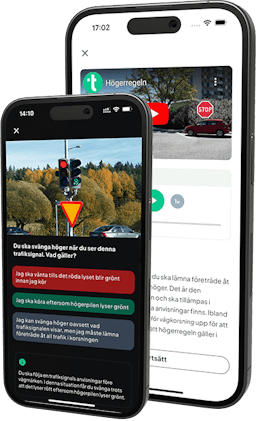In Sweden, around 200 people are killed on the roads each year, and around 2,000 people are seriously injured. In order to reduce the risk of serious injury in an accident, your car is fitted with a number of safety devices; but for these to work, it is important that they are used correctly.
Seat Belt
The seat belt is the most important safety device in the car. In a collision, seat belts keep passengers in their place and prevent them from being thrown forward and injured. For the seat belt to give the best possible level of protection, it should be on tightly and sitting close to the body. It is therefore a good idea to remove (or unbutton) any thick items of clothing, such as a jacket or coat.

New cars are often equipped with seat belt pretensioners which lock the belt in place during a collision. This reduces your risk of being thrown forward against the wheel and suffering injury to your face.
Airbag
Virtually all new cars are fitted with airbags in the driver seat and the front passenger seat. An airbag is a cushion bag which inflates in a collision in order to protect the driver and passengers in the car. It protects people in the car from being injured by the vehicle’s fittings and interior.
Airbags should be used together with seat belts. Because the airbags inflate quite forcefully, they can cause injury themselves if no seat belt is worn. Airbags can also cause injury if you are sitting too closely to them. You should therefore take care to never sit closer than 25 cm from the steering wheel.
It is prohibited to fit a child safety seat in a place where there is an airbag fitted. This is only permitted if the airbag has been deactivated. Children can be seriously injured if they are sitting in a child safety seat when an airbag is inflated.

Headrest
The headrest protects your neck against whiplash. Whiplash injuries are common in connection with collisions from the rear as the head is thrown backwards and then forwards. Adjust your headrest so that it sits level with your head; if it sits too low, it won’t do you any good.
Load in the Car
Loose objects in the car can easily become projectiles in a collision. The forces in a collision can be so strong that they can throw baggage forward and cause injury. It is therefore important that heavy objects in the car are placed as low as possible and preferably strapped down.
Protective Equipment for Children
Children taller than 135 cm can use ordinary seat belts. Children shorter than 135 cm must use a special child safety device. If it is not possible to use a special safety device, there are two exceptions:
- Children who are three years of age or older, but shorter than 135 cm, can use a normal seat belt in the back seat for temporary travel over short distances.
- Children under the age of three can travel for short distances in a taxi, provided that they sit in the back seat.
It is the driver’s responsibility to ensure that children under the age of 15 wear a seat belt or other safety device.
There are essentially four different types of safety device for children: Baby car seat, rear-facing child safety seat, booster seat and booster cushion. The type of safety device you will need often depends on the child’s age and/or weight, although it is primarily height which determines which option to use. Neither baby car seats nor child safety seats should be used if the child’s crown is level with the upper edge of the backrest.
Baby car seats are suitable for the smallest children. This safety device is used up until the child outgrows it, usually at around nine months. Baby car seats are rear-facing as this best protects the child.
Rear-facing child safety seats are suitable for children from around nine months of age up to around four years or until they have grown out of the seat. The seat should be mounted so that it is rear-facing, either in the front seat or in the back seat.

Booster seats or booster cushions are intended for children from around four years of age until they are 135 cm tall. Booster devices are used together with the car’s ordinary seat belt and are front-facing. For maximum protection, they should be placed in the back seat. Use a booster seat if the back seat of your car does not have a headrest.
Important! None of these safety devices are suitable for use in places where there is an active airbag.


